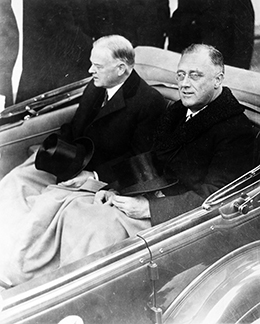| << Chapter < Page | Chapter >> Page > |
As so much of the Hoover presidency is circumscribed by the onset of the Great Depression, one must be careful in assessing his successes and failures, so as not to attribute all blame to Hoover. Given the suffering that many Americans endured between the fall of 1929 and Franklin Roosevelt’s inauguration in the spring of 1933, it is easy to lay much of the blame at Hoover’s doorstep ( [link] ). However, the extent to which Hoover was constrained by the economic circumstances unfolding well before he assumed office offers a few mitigating factors. Put simply, Hoover did not cause the stock market crash. However, his stubborn adherence to a questionable belief in “American individualism,” despite mounting evidence that people were starving, requires that some blame be attributed to his policies (or lack thereof) for the depth and length of the Depression. Yet, Hoover’s presidency was much more than simply combating the Depression. To assess the extent of his inability to provide meaningful national leadership through the darkest months of the Depression, his other policies require consideration.

Although it was a relatively quiet period for U.S. diplomacy, Hoover did help to usher in a period of positive relations, specifically with several Latin American neighbors. This would establish the basis for Franklin Roosevelt’s “Good Neighbor” policy. Following a goodwill tour of Central American countries immediately following his election in 1928, Hoover shaped the subsequent Clark Memorandum —released in 1930—which largely repudiated the previous Roosevelt Corollary, establishing a basis for unlimited American military intervention throughout Latin America. To the contrary, through the memorandum, Hoover asserted that greater emphasis should be placed upon the older Monroe Doctrine, in which the U.S. pledged assistance to her Latin American neighbors should any European powers interfere in Western Hemisphere affairs. Hoover further strengthened relations to the south by withdrawing American troops from Haiti and Nicaragua. Additionally, he outlined with Secretary of State Henry Stimson the Hoover-Stimson Doctrine, which announced that the United States would never recognize claims to territories seized by force (a direct response to the recent Japanese invasion of Manchuria).
Other diplomatic overtures met with less success for Hoover. Most notably, in an effort to support the American economy during the early stages of the Depression, the president signed into law the Smoot-Hawley Tariff in 1930. The law, which raised tariffs on thousands of imports, was intended to increase sales of American-made goods, but predictably angered foreign trade partners who in turn raised their tariffs on American imports, thus shrinking international trade and closing additional markets to desperate American manufacturers. As a result, the global depression worsened further. A similar attempt to spur the world economy, known as the Hoover Moratorium , likewise met with great opposition and little economic benefit. Issued in 1931, the moratorium called for a halt to World War I reparations to be paid by Germany to France, as well as forgiveness of Allied war debts to the U.S.

Notification Switch
Would you like to follow the 'U.s. history' conversation and receive update notifications?